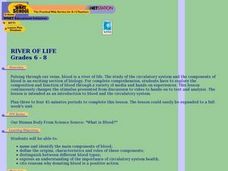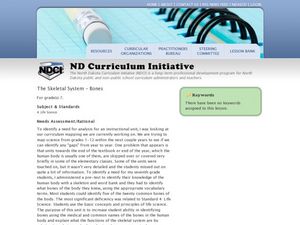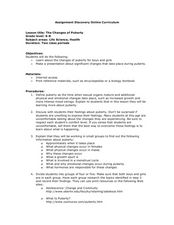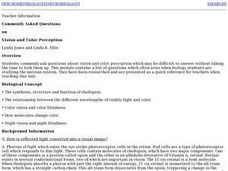Curated OER
The Strength of the Muscular System
Seventh graders investigate the strength of the muscular system. They explore voluntary and involuntary muscle movement and discuss the types of muscles: cardiac or heart, skeletal, and smooth. They visit stations to answer questions...
Curated OER
Introduction of the Human Heart
Fifth graders make their observations about the structure of the human heart. Students trace the flow of blood through the human heart. They touch a model of the human heart, 5th graders read aloud a handout that is found in their...
Curated OER
Skeletal System And External Body Development Of A Full Term Fetus
Students explore the skeletal system and external body development of a full term fetus. In this biology lesson plan, students learn that growth of a full-term fetus' skeletal system and external body parts become more detailed and...
Curated OER
Internal Anatomy: A Fun Look At The Digestive System
Young scholars look at the functions of the body. In this biology lesson plan, students explore the functioning of some body part and construct a "living doll" composed of the body parts discussed.
Curated OER
Regulation - Human Nervous and Endocrine Systems
High schoolers explore homeostasis within the nervous and endocrine system with this Smart Board activity. For this biology lesson plan, students will fill in the know and want to know sections of a KWL chart as a class...
Curated OER
Signal Transmission in the Nervous System
Students determine the speed of nervous transmission in an integrated nervous system. Students understand the differences between signal transmission in a single neuron and in a nervous system. Students create a little group rapport.
Curated OER
Making Connections: Exploring Our Brains through the Five Senses
Students identify structures of the brain, and neurons and analyze their functions. In this nervous system lesson students create drawings and models of anatomy.
Curated OER
River of Life
Students explore the composition and function of blood through a variety of media and hands-on experiences. This lesson is a very good introduction to blood and the circulatory system.
Curated OER
Investigate the Role of Cholesterol from Cholesterol-rich Foods in the Human Body
Eighth graders assess fat content of different food samples. For this biology lesson, 8th graders create a flowchart showing the transport of cholesterol in the bloodstream. They perform tests for the presence of lipids on food...
Curated OER
What's Inside
Students become more familiar with life science in the context of the scientific method which helps them to become familiar with the various kinds of life science diagrams they may see on a GED science test.
Curated OER
THE LAUGHING BRAIN 2: A GOOD LAUGH
Students explore various theories about laughter, laughter's effects on our mental health, and the benefits of laughter to our immune system.
Curated OER
A Child's Journey Through Medicine
Fifth graders identify the symptoms of asthma. In this biology lesson, 5th graders draw and label models of heart and lungs. They conduct a survey on asthma and construct graphs based on result.
Curated OER
One + One=One
Students discover that learning can be fun. Problem solving skills are developed through various writing skills. Empower students with personal concept development and time management. Document growth and success of the learner....
Curated OER
Sizing Up the Supersize Croc
Students examine and compare traits of humans and crocodiles. In this crocodile lesson plan students use a ratio to estimate the height of a person and compare that to a crocodile.
Curated OER
The Skeletal System - Bones
Seventh graders identify the common bones in the human body. In this biology instructional activity, 7th graders research two bones assigned to them. They explain why bones are important to us.
Curated OER
H2O in Us
Students discover through this activity that all organisms are composed of water. They find that 70 percent of their bodies are made up of water that is in thier cells and blood, and not free-flowing throughout their body.
Curated OER
The Changes of Puberty
Students study about the changes of puberty for boys and girls. In this health instructional activity, students study how the body changes during puberty and make a presentation about a significant change that can take place during...
Curated OER
Fishy Behavior
Here's a lab that may make you rethink that morning cup of coffee. Biology scholars test the effects of caffeine, alcohol, and nicotine on the behavior of zebrafish through an intriguing experiment. Learners observe fish...
Curated OER
Introduction to Organ Systems
Students dissect frogs to study the body's organs /organ systems and to think critically about them. This 2-part lesson plan involves mapping the human body's organs & then dissecting a frog.
Curated OER
Antibodies and the Immune Response Lesson Plans - Biology Teaching Thesis
Students are introduced to bacteria and their role in biology and finishes with a lab experiment that focuses on antibiotics. They are given an overview of the important concepts involving bacteria and their potential resistance to...
Curated OER
Body Battles!
Seventh graders explain the role of white blood cells in fighting infections. In this life science instructional activity, 7th graders create flow charts showing the immune response process. They act out and play a game to simulate...
Curated OER
Commonly Asked Questions on Vision and Color Perception
Students commonly ask question about vision and color perception which may be difficult to answer without taking. They use this module that contains a list of questions which often arise when biology students are studying the nervous...
Curated OER
Neural Pictionary
Students explore the nervous system. They pictorially illustrate terms that deal with the nervous system. Students play a "pictionary" game to review nervous system vocabulary words.
Curated OER
The Skeletal System
Students identify the different parts of the skeletal system. In this biology activity, students put together a skeleton using an interactive website. They evaluate the accuracy of their own answers.























